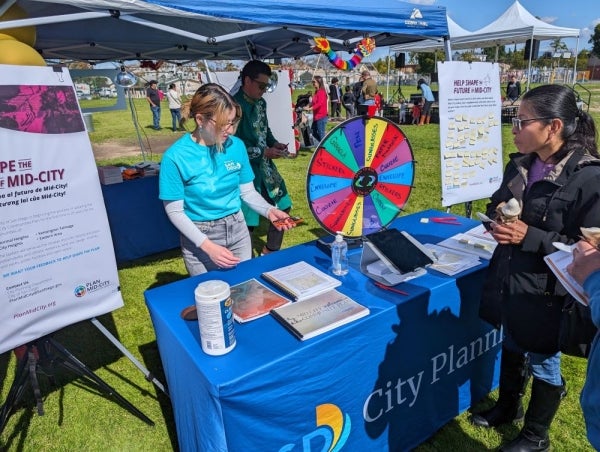Inclusive Engagement Techniques and Approaches
Pop-Up Events

What is it?
A pop-up event, sometimes known as “tabling,” is a temporary activity set up in a public or private space to engage the community in a specific activity or topic. These activities are typically short-term, ranging from an hour to a full day, and are designed to capture the attention of passersby. They can be standalone or incorporated as part of major community events or festivals.
When to use it
Pop-up events can create a sense of in-person community connection by meeting people where they are. Pop-ups can be particularly effective to raise awareness about a project or gather feedback from people who may not typically attend formal public engagement events or meetings.
How to do it
Before
- Consider pop-up locations at high-traffic places or events where the intended audience naturally gathers or visits, such as sporting events, schools, plazas and shopping centers and community centers.
- Consider partnering with other organizations to co-host a pop-up event. For example, if engaging on a City project that promotes community health, consider collaborating with a health organization’s pop-up medical screening event. This creates a trusted setting for engagement while recognizing that public engagement is secondary to the event’s primary purpose.
- Choose venues that are fully accessible, including parking, entrances and restrooms. Choose venues that are near transit and that have adequate parking.
- Obtain any necessary approvals if considering a pop-up on private property. Pop-ups of a large scale in the public right-of-way may require a special event permit.
- Schedule pop-up events during times when people are likely to be out and about, such as lunch hours.
- Create a logistics plan that outlines the roles, shift schedules, activities, outreach materials and supplies associated with the pop-up event.
- Ensure City staff subject matter experts are available to address questions the public may have.
- More complex engagement activities may warrant a flow diagram, which is a sketch of how the setup will be organized within the tent canopy/table area.
- Staff should wear similar attire such as a City-branded T-shirt.
- Prepare an optional sheet for interested passersby to sign up for ongoing notifications.
- Check weather conditions in advance of the pop-up event.
- Remind staff to dress accordingly.
- If temperatures of 80°F or higher are anticipated, ensure water and shade are available and/or consider postponing the event.
During
- Provide activities and materials that are interactive and engaging to draw people in. This could include quick and simple games or demonstrations.
- Consider providing participation support.
- If applicable, provide tablets for digital participation or printed surveys.
After
- Digitize/upload public input collected to guide project decision-making.
- Follow up with participants as needed.
Resource considerations
![]()
Cost: Minimal
Costs for pop-up events are typically low, including any printed materials, games and participation support.
![]()
Time: Minimal to Moderate
Staff can plan and deploy a pop-up event within a few weeks assuming that the department has access to a foldable table, chairs and tent canopy.
![]()
Capacity: Moderate
Three to four staff members is recommended in order to have the capacity to interact with larger crowds and support logistical needs.
Other considerations
- If joining a local event, coordinate with other City departments that might already be engaging about similar topics in this event.
- Check weather conditions in advance of the event.
- Remind team members to dress accordingly.
- If temperatures at 80°F or higher are anticipated, ensure water and shade are available and/or consider postponing the event.
- Ensure parking directions and instructions are provided for staff carrying materials, especially for loading and unloading.
- Always prioritize safety. When handling heavy items, seek assistance to avoid strain or injury.
How to make it more inclusive
- Choose locations or occasions that will offer opportunities to engage with people who are less likely to attend a public engagement event.
- Provide printed outreach material in all relevant languages for the intended audience.
Inclusive Engagement Techniques and Approaches
- Introduction
- Appreciative Inquiry
- Arts-based Engagement
- Briefings
- Comment Forms
- Community Cafés
- Community Mapping
- Community Office Hours
- Email Notifications
- Engagement through Service
- Fact Sheets
- Flyers
- Focus Groups
- Game-based Approaches
- Hotlines
- Information Kiosks
- Interviews
- Meeting in a Box
- Mobile Engagement
- News Releases
- Newsletters
- Open Houses
- Participation Support
- Pop-Up Events
- Project Models
- Project-specific Groups
- Public Meetings
- Public Service Announcements (PSAs)
- Social Media
- Surveys and Polls
- Tours and Field Trips
- TV/Radio/Podcast Interviews
- Vision Walls
- Web-Based/Hybrid Meetings
- Webpages
- Workshops


 Inclusive Public Engagement Guide
Inclusive Public Engagement Guide